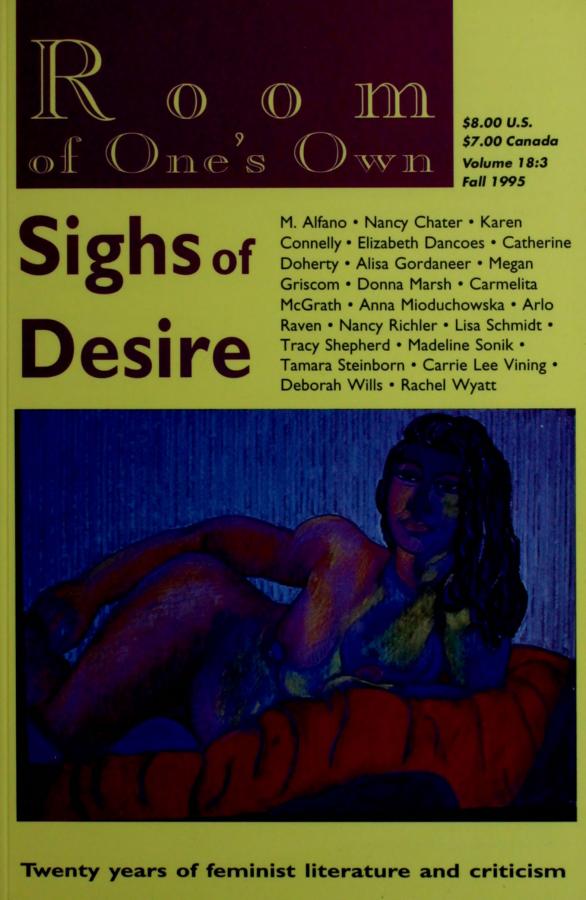Sighs of Desire | 18.3
1995
Digital only; out of stock in print.
The issue of Room of One’s Own you are holding in your hands represents a cross-section of what women told us about desire. Our proposal for an issue on women’s desire began as a gleam in my editorial eye, germinated at a meeting of the collective, and grew wildly through our call for submissions. We were not at all prepared for the cross-section we received. So what is the size and shape of desire, and how has it come to look that way?
About twenty-five years ago, desire became a sexy topic, if you’ll pardon the double entendre. I distinctly recall listening, while riding the school bus home from senior high, to a broadcaster acknowledge that women had orgasms. I’m certain the bus driver promptly switched to a pop station, probably playing the song making people blush that year: Light My Fire by The Doors. Women had suddenly become sexual beings, not shrinking from sex by feigning sick headaches, but deliriously engaging in what was portrayed as horizontal roto-routing—and having spontane ous orgasms, at that. Women’s desire was defined by those who held the keys to broadcast and print media and, not surprisingly, looked rather like an adolescent wet dream.
Here we are in 1995, and the portrayal of women’s desire in mainstream media hasn’t changed all that much. Discussion of women’s sexual desire went out of fashion for a while—Ann Landers polled her readers and discovered women want cuddling more than penetration, feminists demanded an alternative to objectification, and we discovered that the readers most appreciating Playgirl were our gay male friends—but it was never supplanted by a discussion of women’s other desires. Today the topic is back, and looks to me like the old machinations with a few twists: latex gloves to be safe, body piercing to be trendy, and gender-bending for good measure, but surely focused on sexual activity.
Our issue on desire is something ofa litmus test: what would women tell us, aside from the hype and away from mainstream expectations? Well, sex was one of the more prominent themes, though lust seemed to be an exclusively lesbian topic. Heterosexual women expressed desire for things peripheral to sex: not to be objectified, to be respected, to be desired as whole beings, complete with human strengths and fail ings. Other women desired to be reunited with lost mothers, to recapture a state of innocence, to love themselves, and to live fully, without regrets. Women desired courage, fortitude, and even the permission to desire.
The theme for this issue began as “persistent desire,” until I realized I had plagarized it from a book edited by Joan Nestle. Our new title reflects our empathy of the profound emotions expressed by the contributors to this issue.

$10.00
Additional information
| Delivery | Canada, USA, International, Digital |
|---|
In this issue: Michelle Alfano, Ronnie R. Brown, Nancy Chater, Karen Connelly, Elizabeth Dancoes, Catherine Doherty, Leslie Fawkes, Alisa Gordaneer, Megan Griscom, Maureen Hynes, Donna Marsh, Carmelita McGrath, Anna Mioduchowksa, Wendy Putman, Arlo Raven, Nancy Richler, Lisa Schmidt, Marial Shea, Madeline Sonik, Tamara Steinborn, Carrie Lee Vining, Deborah Wills, Rachel Wyatt